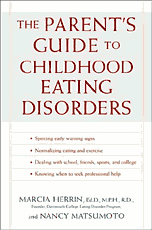|
In the new book "The Parent’s Guide to
Childhood Eating Disorders," Harvard Medical School Professor David
Herzog writes, "It is estimated that more than six million women and
perhaps over half a million men have a clinical eating disorder at
some point in their lives. Increasingly it is the preteen, or even
younger child, who first begins to struggle with food, exercise, and
weight issues." It is this struggle and the ways that parents can
combat this condition that is a central theme of this book.
Written by Dr. Marcia Herrin, a
specialist in eating disorders, and writer Nancy Matsumoto, the book
helps parents spot the early warning signs of eating disorders,
develop a normal eating and exercise routine, understand the effect
that school, friends, sports and college can have on eating habits,
and know when to seek professional help.

"Identifying an Eating Disorder"
In this section the authors describe
how to spot the early warning signs of an eating disorder. They also
explain the difference between bad eating habits and the more
complex behavioral problems sometimes associated with eating. They
devote special attention to the most common (and serious) eating
disorders: anorexia nervosa, bulimia nervosa and binge eating. A
watchful eye is a key to preventing these disorders from taking over
a child’s life. Strategies include building self-esteem, seeking
help for depression, teaching healthier coping mechanisms and
watching for early signs of changes in behavior.
One component in prevention is the role
of the family. Aside from striving for a close, communicative
parent-child relationship, parents should also eat together as a
family as often as possible, allow the child some privacy and
emphasize the positive effects of a stable father-child
relationship.
The concluding chapter helps parents
understand the medical consequences of an eating disorder.
"Taking Action"
There are several steps parents can
take if they believe that their child has an eating disorder.
Parents who approach their child about this subject can expect
resistance, anger, denial or outright hostility. How do you broach
such a sensitive subject with your child? The authors recommend that
parents plan the conversation in advance, put yourself in your
child’s shoes, avoid the blame game and most importantly, use words
that work. It is important during this time that parents not fall
into a "blame-game" trap.
There are many factors for parents to
consider if they believe their child has an eating disorder. One
common factor is genetics. According to the authors, some
researchers feel that people can inherit a certain brain chemistry
that makes them more prone to food problems. Another factor is the
parent’s own attitude towards food and body image, an attitude that
can have a profound effect on a child’s eating habits.
[to top of second column in this
review]
|

Outside of their family, children can
come under the influences of friends, school, camp or college. A
discussion about weight and dieting in a close circle of friends is
one example. Teasing at school is another example. It is essential
that parents understand that dealing with a child’s disorder at home
is quite different from "sending your child, eating problems and
all, into the wider world of friends, school, camp, or college."
"Healthy Eating Guide"
One goal in helping a child with an
eating disorder is to develop a habit of healthy eating and
nutrition. The authors suggest a normalized eating regime based on a
food plan that stabilizes the child’s intake of fat, calcium,
protein and carbohydrates at breakfast, lunch and dinner. The plan
even makes allowances for the inclusion of snacks and fun foods in
the daily diet. Incorporating exercise into the daily routine is
another component of healthy eating.
For those children who relapse into old
habits, the authors provide "relapse training strategies" that
identify high-risk situations such as facing dangerous foods,
abandoning the food plan, mood swings, stress and perceived threats
to one’s body image.
In the final chapter the authors
discuss the measures that parents can take when they have done
everything they can do and feel that a solution is beyond their
reach. Some of the tips include determining the type of professional
help your child needs, how to find and evaluate professionals, and
when inpatient or residential care should be considered.

In the introduction to "The Parent’s
Guide to Childhood Eating Disorders" Dr. Herzog writes that this
book is a "welcome addition to the library of the clinician working
in the field of eating disorders and is an invaluable guide for the
parent eager to learn how to battle often frightening
eating-disordered attitudes and behaviors."
The book’s
appendices contain information on diagnosing eating disorders, body
weight assessments, support groups, residential/hospital programs
and lists for further reading. Anyone who suspects that a child is
suffering from some type of eating disorder should make this book
one of the first sources of information consulted on this subject.
[Richard Sumrall, Lincoln
Public Library District] |